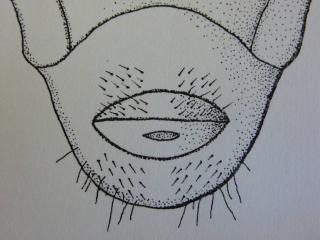Description and life cycle
Adults (beetles)
Newly emerged African black beetle adults are brown and fairly soft, but within hours they harden and darken to a glossy black. They are 12 to 14mm long with females being slightly larger than males. The end segments on the front legs of females are the same diameter as other legs, but are thicker on males.
Adults are strong fliers, even though they are regarded as 'pseudo soil insects' because they feed near or just under the soil surface on plant stems and roots.
Eggs
Eggs are cream to white, oval and about 1.8mm long. Eggs are laid singly into the soil just under the vegetation mat, and can be seen clearly with the naked eye. They may be confused with eggs of other beetles, snails and slugs. Females lay about 30 eggs each in their lifetime.
Larvae
The larva is a typical C-shaped cockchafer with a brown head capsule, black jaws and three pairs of legs on the thorax.
There are three larval stages or instars. The larva moults between each instar, increasing steadily in size with each moult. The head capsule is an average of 1.4mm for first, 2.5mm for second and 4.0mm wide for third instars. Mature larvae are around 8mm diameter and 25mm long.
Larvae of the very abundant lesser pasture cockchafer (Australaphodius frenchi), is similar in appearance. However the larvae are smaller, growing to about 1.5mm in diameter and 5mm long.
African black beetle larvae are creamy-white, except for the brown head-capsule and the hind segments, which appear dark where the contents of the gut show through the body wall. From the second instar stage these larvae are easily identifiable as they are the largest and most common of the cockchafer group in pastures in the coastal areas.
The more mature large larvae of other species of cockchafer and African black beetle can be distinguished by naked eye based on the structure of the anal opening. For African black beetle, the opening and associated spines are horizontal. Other species of cockchafer larvae have a vertical anal opening.
Most larvae feed just below the surface of pasture within the main root mat. Wet conditions during the egg and first instar larval stages are fatal, but as the larvae grow their ability to cope with high moisture levels increases. In very dry soil, larvae will burrow to avoid such dry conditions.
When they have finished feeding, the larvae (about 25mm long) clear their guts, becoming more cream in colour. They steadily shorten and become more rounded as they change into the pupal stage.
Pupae
The pupa or resting stage is pale yellow at first, but changes to a reddish brown as it approaches the adult stage. They are about 8mm wide and 1.5cm long.

